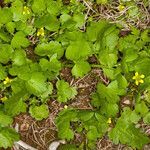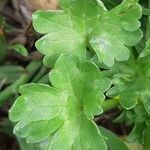Annual; roots all fibrous. Stems moderately stout, erect, glabrous or very sparsely hairy, 10-30-(50) cm tall. Basal lvs subcircular, 3-5-lobed to c. 3/4 way, 3-5 × 3-5 cm; lobes obovate, cuneate, dentate, sparsely hairy on veins and margins; petioles glabrous, 5-15 cm long. Cauline lvs similar to basal but lobes becoming lanceolate, entire; uppermost lvs sometimes not lobed, lanceolate, entire. Fls 1-3-(10) per stem, 10-20 mm diam. Pedicels erecto-patent, sparsely hairy, terete, 15-60 mm at fruiting. Sepals 5 with sparse long hairs, acute, 5-6 mm long with apex deflexed at flowering. Petals 5, yellow, obovate, 7-9 × 3-4 mm; nectary single, 1-2 mm from petal base, covered by an obtuse to truncate scale. Receptacle hairy. Achenes 15-25, strongly flattened, distinctly bordered, broadly obovate; body 3-5-(7) × 2.5-3.5 mm; face with strong, long, curved spines especially near the margin; beak curved at tip, c. 2 mm long.
Herbs annual. Stems 5--28 cm, glabrous, branched. Basal leaves 6--9; petiole 3.4--12 cm, subglabrous; blade 3-lobed, broadly ovate or orbicular-ovate, 1.6--5.5 × 1.8--4.2 cm, papery, glabrous, base subtruncate or truncate-cuneate; central lobe rhombic-obtrapeziform, 3-lobed or few dentate; lateral lobes obliquely ovate, unequally 2-lobed, incised-dentate. Lower stem leaves similar to basal leaves; upper ones shortly petiolate, broadly ovate. Flowers solitary, leaf-opposed, 1--1.6 cm in diam. Pedicel 1--3 cm, glabrous or pilose. Receptacle pilose. Sepals 5, narrowly ovate, 5--6 mm, abaxially sparsely pilose. Petals 5, narrowly obovate, 3--8 × 2.5--4 mm, nectary pit covered by a scale, apex rounded. Stamens numerous. Aggregate fruit subglobose, ca. 1.2 cm in diam. Achene complanate, elliptic or obovate, 4--5 × ca. 3 mm, glabrous, narrowly marginate, spiny, spines 0.5--1 mm; style persistent, ca. 2 mm. Fl. Mar--Apr.
Suberect or spreading annual, glabrous to pilose. Basal leaves with petioles 5–15 cm long; lamina ± orbicular, 1.5–5 cm long, ± cordate, with 3–5 shallow rounded coarsely crenate-dentate lobes. Upper cauline leaves ± cuneate, with 3 narrow, entire or toothed segments. Flowering stems 10–50 cm high, 1–10-flowered. Sepals 5, strongly reflexed, ovate, c. 5 mm long, sparsely pilose below. Petals 5, obovate, 7–9 mm long, slightly longer than sepals, yellow; nectary near petal-base, with lobe obovate to cuneate, 1–2 mm long, free for up to half this length. Stamens 15–20. Pistils 8–20. Receptacle pubescent. Achenes broadly obovate, 5–8 mm long, flattened, brown; margin strongly keeled and grooved, smooth, green; faces with numerous short, acute tubercles (rarely almost smooth); beak stout, 2–3 mm long, nearly straight.
Stems reclining or erect, glabrous or sparsely pilose. Basal and lower cauline leaf blades broadly cordate to reniform or semicircular, undivided or 3-lobed, 2-5 × 3-6.5 cm, base rounded to cordate, margins coarsely crenate, apex rounded. Flowers pedicellate; receptacle hispid; sepals 5, reflexed, 4-7 × 2-3 mm, sparsely bristly; petals 5, 4-8 × 2-4.5 mm. Heads of achenes globose, 13-16 × 13-16 mm; achenes 10-20 per head, 5-5.5 × 3-3.5 mm, faces covered with long spines, glabrous, margin smooth; beak lanceolate, curved, 2-2.5 mm.
Annual to 30 cm. Leaves round, on long petioles, 3-lobed and toothed. Flowers in open panicles, yellow. Achenes spiny, 7-8 mm long.
A herb. It grows each year from seed. The flowers are yellow.












